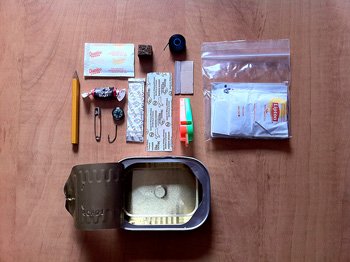Survival Bag
Having a survival bag ready in case a disaster occurs without warning gives you an advantage over others who were not prepared for such an emergency. Although some disasters such as floods or tornadoes are frequently foreseeable, other calamities such as earthquakes, power outages and even a bioterrorist attack are not.
Keeping necessary and functional items collected in one portable container saves time and frustration when trying to collect all these things after a disaster has happened.
Pocket Survival Kits

Photo courtesy of mikepetrucci
These mini survival kits are handy to take along if you plan on camping or hiking in wilderness areas with which you are unfamiliar. Also called Bug-Out Altoid Tins, Bug Out Bag (BOB) or survival kit in a can, the pocket survival kits are small enough to be carried in your pants or coat pocket and provides the bare essentials needed to survive an emergency situation.
Some of the items that could be included in a miniature survival bag are:
- Lighter/matches
- Survival whistle
- Fishing line/hook
- Water purification tablets
- Bouillon cubes/candy/glucose tablets
- Compass
- Bandages
- Small mirror
- Aspirin
- Ziploc baggie, to gather water
What is packed also depends on the type of environment. Someone planning on hiking in the Amazon jungle might pack quinine tablets and insect-repellant ointment for treatment of malaria, whereas a trip to the desert would not warrant taking along fishing line and hooks.
Winter Survival Kits
Useful winter survival kits should be kept in a car and contain items like:
- Small flashlight
- Emergency blanket
- Hand warmer
- Water purification tablets
- High-calorie protein bars
- Bandages
- Lighter/matches
- Pocket knife
Being stranded on a deserted and desolate road with a blizzard bearing down is the scenario in which you need the assistance of a packed survival bag. While these few items may not seem like much, they are the basics necessary for self-reliance and survival in a hostile environment.
Survival Food Kits
Foods conducive to surviving situations in which conventional methods for obtaining food are no longer viable are canned, freeze-dried and dehydrated food. Freeze-dried is preferable, because this process is capable of locking in more flavor and nutrients than dehydrating foods.
Survival food kits are packed to last one individual anywhere from three to seven days. Examples of freeze-dried food are macaroni and cheese, beans and rice and oatmeal. Further, when stored in a dry and cool place, freeze-dried foods can last up to 25 years without spoiling because each package is flushed with nitrogen to prevent oxidation.
Three-Day Bug Out Bags
A survival bag containing outdoor survival equipment is called a "bug-out" bag. Items included in a typical bug-out bag (BOB) are:
- Crossbow
- Folding shovel
- Small axe
- Knife
- Battery- or crank-powered radio
- Water
- Waterproof matches
- Solar blanket
- Whistle
- Emergency candles
- Fishing line/hooks
Another handy item to keep in a bug-out bag is a list of survival tips facilitating survival in all wilderness conditions. Stress, lack of sleep and fear can create a sense of confusion, which could inhibit memory as well as clear thinking. Basic survival tips include:
- Utilizing natural shelters — Lean-tos are built by layering branches and deadwood. If possible, construct a shelter underneath evergreen trees where the area is usually clean and dry. Dead leaves make insulating floors for shelters as well.
- Pieces of large plastic are effective as emergency shelters or can enhance an existing natural shelter.
- If you have the materials, infusing cotton balls with Vaseline or other petroleum jelly product makes tinder. Otherwise, use tree moss, birch bark or cattail to start a good fire.
- A general rule of thumb when eating unknown plants is to avoid consuming foliage that seeps white sap, is hairy, contains flowers that are umbrella-shaped or has green or white berries. Berries that are blue or black are usually, though not always, safe to eat.
Keeping some kind of survival bag stocked and available for immediate use at home, in your car, at work or while vacationing in remote areas can prevent you from suffering the distress and anxiety caused by unexpected disasters.
Return from Survival Bag to Disaster Survival Kit





New! Comments
Have your say about what you just read! Leave me a comment in the box below.